
Concept explainers
Figure 21−9 shows a compound gear train. Gears B and C are keyed to the same shaft; therefore, they turn at the same speed. Gear A and gear C are driving gears. Gear B and gear D are driven gears. Set up a proportion for each problem and determine the unknown values, x, y, and z in the table. Round the answers to 1 decimal place where necessary.
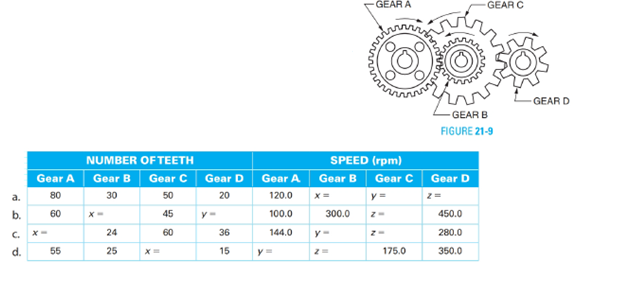
(a)
To find the speed of the different gears given in the problem.
Answer to Problem 16A
Speed of gear B is
Speed of gear C is
Speed of gear D is
Explanation of Solution
Given information:
A gear and pinion arrangement is given as below.
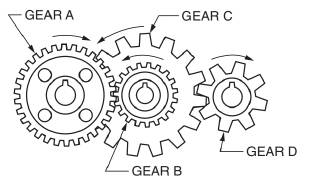
Calculation:
We have been given below information,
As we know that in a gear arrangement,
13
So,
Hence, speed of gear B is
Since, gear B and C are on same shaft. So, speed of both gear is equal.
Therefore, speed of gear C is
Again,
Hence, speed of gear D is
Thus, speed of gear B is
Speed of gear C is
Speed of gear D is
(b)
To find the number of teeth in the gear and the speed of the gear.
Answer to Problem 16A
Number of teeth in gear B is
Number of teeth in gear D is
Speed of gear C is
Explanation of Solution
Given information:
A gear and pinion arrangement is given as below.
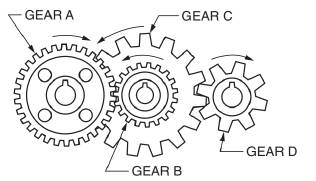
Calculation:
We have been given below information,
As we know that in a gear arrangement,
So,
Hence, number of teeth in gear B is
Since, gear B and C are on same shaft. So, speed of both gear is equal.
Therefore, speed of gear C is
Again,
Hence, number of teeth in gear D is
Thus, number of teeth in gear B is
Number of teeth in gear D is
Speed of gear C is
(c)
To find the number of teeth as well as speed of the gear.
Answer to Problem 16A
Number of teeth in gear A is
Speed of gear B is
Speed of gear C is
Explanation of Solution
Given information:
A gear and pinion arrangement is given as below.
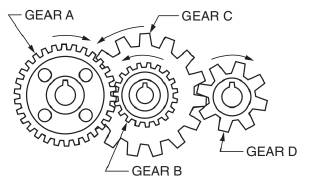
Calculation:
We have been given below information,
As we know that in a gear arrangement,
So,
Since, gear B and C are on same shaft. So, speed of both gear is equal. i.e.
Again,
Hence, speed of gear B and gear C is
Putting,
Thus, number of teeth in gear A is
Speed of gear B is
Speed of gear C is
(d)
To find the speed of the different gears and the number of teeth.
Answer to Problem 16A
Number of teeth in gear C is
Speed of gear A is
Speed of gear B is
Explanation of Solution
Given information:
A gear and pinion arrangement is given as below.
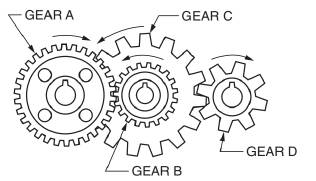
Calculation:
We have been given below information,
As we know that in a gear arrangement,
So,
Since, gear B and C are on same shaft. So, speed of both gear is equal. i.e.
Putting
Hence, speed of gear A is
Again,
Hence, number of teeth in gear C is
Thus, number of teeth in gear C is
Speed of gear A is
Speed of gear B is
Want to see more full solutions like this?
Chapter 21 Solutions
EBK MATHEMATICS FOR MACHINE TECHNOLOGY
- Q3)A: Given H(x,y)=x2-x+ y²as a first integral of an ODEs, find this ODES corresponding to H(x,y) and show the phase portrait by using Hartman theorem and by drawing graph of H(x,y)-e. Discuss the stability of critical points of the corresponding ODEs.arrow_forwardQ/ Write Example is First integral but not Conservation system.arrow_forwardQ/ solve the system X° = -4X +2XY-8 y°= 2 4y² - x2arrow_forward
- Q4: Discuss the stability critical point of the ODES x + sin(x) = 0 and draw phase portrait.arrow_forwardUsing Karnaugh maps and Gray coding, reduce the following circuit represented as a table and write the final circuit in simplest form (first in terms of number of gates then in terms of fan-in of those gates). HINT: Pay closeattention to both the 1’s and the 0’s of the function.arrow_forwardRecall the RSA encryption/decryption system. The following questions are based on RSA. Suppose n (=15) is the product of the two prime numbers 3 and 5.1. Find an encryption key e for for the pair (e, n)2. Find a decryption key d for for the pair (d, n)3. Given the plaintext message x = 3, find the ciphertext y = x^(e) (where x^e is the message x encoded with encryption key e)4. Given the ciphertext message y (which you found in previous part), Show that the original message x = 3 can be recovered using (d, n)arrow_forward
- Theorem 1: A number n ∈ N is divisible by 3 if and only if when n is writtenin base 10 the sum of its digits is divisible by 3. As an example, 132 is divisible by 3 and 1 + 3 + 2 is divisible by 3.1. Prove Theorem 1 2. Using Theorem 1 construct an NFA over the alphabet Σ = {0, 1, 2, 3, 4, 5, 6, 7, 8, 9}which recognizes the language {w ∈ Σ^(∗)| w = 3k, k ∈ N}.arrow_forwardRecall the RSA encryption/decryption system. The following questions are based on RSA. Suppose n (=15) is the product of the two prime numbers 3 and 5.1. Find an encryption key e for for the pair (e, n)2. Find a decryption key d for for the pair (d, n)3. Given the plaintext message x = 3, find the ciphertext y = x^(e) (where x^e is the message x encoded with encryption key e)4. Given the ciphertext message y (which you found in previous part), Show that the original message x = 3 can be recovered using (d, n)arrow_forwardFind the sum of products expansion of the function F(x, y, z) = ¯x · y + x · z in two ways: (i) using a table; and (ii) using Boolean identities.arrow_forward
- Give both a machine-level description (i.e., step-by-step description in words) and a state-diagram for a Turing machine that accepts all words over the alphabet {a, b} where the number of a’s is greater than or equal to the number of b’s.arrow_forwardCompute (7^ (25)) mod 11 via the algorithm for modular exponentiation.arrow_forwardProve that the sum of the degrees in the interior angles of any convex polygon with n ≥ 3 sides is (n − 2) · 180. For the base case, you must prove that a triangle has angles summing to 180 degrees. You are permitted to use thefact when two parallel lines are cut by a transversal that corresponding angles are equal.arrow_forward
 Holt Mcdougal Larson Pre-algebra: Student Edition...AlgebraISBN:9780547587776Author:HOLT MCDOUGALPublisher:HOLT MCDOUGAL
Holt Mcdougal Larson Pre-algebra: Student Edition...AlgebraISBN:9780547587776Author:HOLT MCDOUGALPublisher:HOLT MCDOUGAL College Algebra (MindTap Course List)AlgebraISBN:9781305652231Author:R. David Gustafson, Jeff HughesPublisher:Cengage Learning
College Algebra (MindTap Course List)AlgebraISBN:9781305652231Author:R. David Gustafson, Jeff HughesPublisher:Cengage Learning Elementary AlgebraAlgebraISBN:9780998625713Author:Lynn Marecek, MaryAnne Anthony-SmithPublisher:OpenStax - Rice University
Elementary AlgebraAlgebraISBN:9780998625713Author:Lynn Marecek, MaryAnne Anthony-SmithPublisher:OpenStax - Rice University Mathematics For Machine TechnologyAdvanced MathISBN:9781337798310Author:Peterson, John.Publisher:Cengage Learning,
Mathematics For Machine TechnologyAdvanced MathISBN:9781337798310Author:Peterson, John.Publisher:Cengage Learning, Algebra: Structure And Method, Book 1AlgebraISBN:9780395977224Author:Richard G. Brown, Mary P. Dolciani, Robert H. Sorgenfrey, William L. ColePublisher:McDougal Littell
Algebra: Structure And Method, Book 1AlgebraISBN:9780395977224Author:Richard G. Brown, Mary P. Dolciani, Robert H. Sorgenfrey, William L. ColePublisher:McDougal Littell Elementary Geometry For College Students, 7eGeometryISBN:9781337614085Author:Alexander, Daniel C.; Koeberlein, Geralyn M.Publisher:Cengage,
Elementary Geometry For College Students, 7eGeometryISBN:9781337614085Author:Alexander, Daniel C.; Koeberlein, Geralyn M.Publisher:Cengage,





